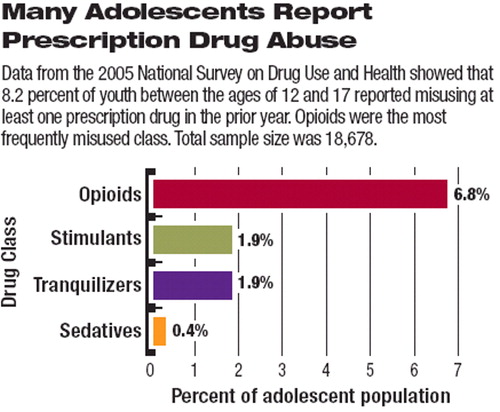Screening Urged to Prevent Prescription Drug Abuse
Risk-taking tendencies, major depression, and other substance use problems are some of the major risk factors linked to teens' misuse of prescription drugs, a study in the July Journal of the American Academy of Child and Adolescent Psychiatry shows.

According to data collected in the 2005 National Survey on Drug Use and Health (NSDUH), one in 12 adolescents aged 12 to 17 (8.2 percent) reported having misused at least one prescription medication in the previous year. This prevalence trailed only the use of alcohol, tobacco, and marijuana.
Misuse was defined as “any intentional use of a medication with intoxicating properties outside of a physician's prescription for a bona fide medical condition, excluding accidental misuse.”
Opioids such as hydrocodone and oxycodone are by far the class of medications most frequently misused by adolescents, followed by stimulants (for example, amphetamines and methylphenidate), tranquilizers (including benzodiazepines and muscle relaxants), and sedatives (for example, barbiturates).
In this study, Ty Schepis, Ph.D., and Suchitra Krishnan-Sarin, Ph.D., from the Department of Psychiatry at Yale University School of Medicine found that prescription drug misuse among adolescents was significantly linked to poor academic performance, a major depressive episode in the past year, risk-taking tendencies, a history of mental health treatment in the past year, and the concurrent use of other substances, including cigarettes, alcohol, marijuana, cocaine, or inhalants.
Thirty-six percent of these adolescents who misused medications had symptoms that met one or more DSM-IV criteria for substance use disorder. “It was somewhat unexpected to see that over a third of the adolescents misusing prescription drugs have begun to develop symptoms of dependence,” Schepis commented to Psychiatric News.
The high rate of adolescents with co-existing substance use problems is consistent with findings from other studies, the authors pointed out. They urged clinicians to screen young patients routinely for possible prescription misuse and educate parents about the high risk of such misuse.
“There is anecdotal evidence to suggest that prescription drugs are perceived to be safer or less problematic than illicit substances,” Schepis said. In addition, because prescription drugs are legal, teenagers may have easier access to painkillers, stimulants, and tranquilizers than to illegal substances, especially if parents are not monitoring their medicine cabinets.
“We can combat the supply of illicit drugs, but it's a lot harder to control the supply of prescription medications because they have legitimate medical indications,” he said.
Clinicians should be more proactive in educating parents and adolescents about the dangers of misusing prescription medications, Schepis suggested, especially considering the high prevalence of substance use disorder symptoms among these teenagers.
Another notable finding was that adolescent girls had a slightly higher prevalence of misusing opioids, stimulants, and tranquilizers than did their male peers. This trend is consistent with some adult surveys that found a higher rate of misusing prescription medications by women than by men.
The NSDUH is an annual in-home survey sponsored by the Substance Abuse and Mental Health Services Administration that tracks trends in substance use throughout the United States. The sample used in this study comprised 18,678 adolescents, and the results were extrapolated to population estimates. This study was supported in part by a grant from the National Institutes of Health.
“Clinicians must educate adolescents about the difference between proper and improper use,” said Schepis. “Adolescents may not fully understand the potential harm in misusing prescription drugs like overdose and developing addiction.”
An abstract of “Characterizing Adolescent Prescription Misusers: A Population-Based Study” is posted at<www.jaacap.com/pt/re/jaacap/abstract.00004583-200807000-00006.htm>.▪



